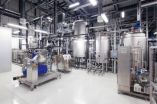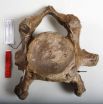(Press-News.org) LOS ANGELES (March 24, 2014) – New research suggests that gut microorganisms do not merely influence immune cell function, but also support the production of immune cells that form the first line of defense against infection. By understanding the mechanisms responsible for maintaining and replacing immune cells, researchers hope to one day develop targeted therapies to support and boost immune function in humans.
Study investigators from the Regenerative Medicine Institute at Cedars-Sinai collaborated with the Mount Sinai School of Medicine and lead institution — the California Institute of Technology.
Previous research studies have evaluated the influence of gut microbes on the function of immune cells, but little had been known about their influence on the production of immune cells, a process known as hematopoiesis.
In this study, published in the journal Cell Host & Microbe, investigators found that mice lacking gut microbes were defective in immune cell production. Immune cell populations have to be maintained and replaced to ensure enough immune cells are available to fight infection. Consequently, the investigators noted that mice lacking gut microbes were more susceptible to bacterial infections.
"This work provides important clues about the role of gut microbes in supporting a healthy immune system that is capable of providing efficient protection from infection," said Helen Goodridge, PhD, collaborating author, assistant professor in the Department of Biomedical Sciences and a research scientist in the Regenerative Medicine Institute. "We now have a clearer understanding of how gut microbes influence immune cell production, which has implications for immune defense against infection."
Findings also suggest that antibiotics may have unwanted effects on the immune system by depleting gut microbes and thereby compromising immune cell production, which could make a patient more susceptible to subsequent infections. However, the data also indicate that it might be possible to prevent this effect, at least partially, by delivering microbial components along with the antibiotics to stimulate immune cell production.
"As we found true in mouse models, we also believe that depletion of gut microorganisms in humans could lead to a suppressed immune system and a higher risk of acquiring a broad range of infections and diseases," said Alberto Yáñez, PhD, collaborating author on the study and a postdoctoral scientist in the Goodridge Laboratory. "Gut microbes play very important roles in maintaining human health and this study further highlights the risks associated with the overuse of antibiotics that indiscriminately target helpful, as well as harmful, bacteria."
The rise of antibiotic-resistant superbugs, paired with a dwindling supply of effective antimicrobial drugs, has increased the threat of infectious disease and created a healthcare crisis. If these findings are validated in humans, researchers may herald future medical approaches to address the re-emerging crisis of infectious diseases.
INFORMATION:
Sarkis K. Mazmanian, PhD, professor of Biology and Biological Engineering, and Arya Khosravi, MD, PhD, candidate at the California Institute of Technology, led this multicenter study. Additional authors include Miriam Merad, MD, PhD, professor of oncological sciences and medicine, and Jeremy Price and Andrew Chow, candidates in the MD/PhD program at The Tisch Cancer Institute and Immunology Institute at the Mount Sinai School of Medicine.
The research was supported by a pre-doctoral training grant from the National Institute of Health (GM007616), a Burroughs Wellcome Fund in the Pathogenesis of Infectious Disease award to Sarkis K. Mazmanian, PhD, as well as the Cedars-Sinai Regenerative Medicine Institute.
Citation: Cell Host & Microbe. 2014 March: "Gut Microbiota Promotes Hematopoiesis to Control Bacterial Infection."
Research study takes deeper look at the role of gut microbes in the immune system
2014-03-25
ELSE PRESS RELEASES FROM THIS DATE:
Replacing insulin through stem cell-derived pancreatic cells under the skin
2014-03-25
LA JOLLA, Calif., March 25, 2014 – Sanford-Burnham Medical Research Institute (Sanford-Burnham) and UC San Diego School of Medicine scientists have shown that by encapsulating immature pancreatic cells derived from human embryonic stem cells (hESC), and implanting them under the skin in animal models of diabetes, sufficient insulin is produced to maintain glucose levels without unwanted potential trade-offs of the technology. The research suggests that encapsulated hESC-derived insulin-producing cells hold great promise as an effective and safe cell-replacement therapy ...
Complex brain functional network connection after stroke
2014-03-25
Studies have shown that functional network connection models can be used to study brain network changes in patients with schizophrenia. A research team from Huazhong University of Science and Technology in China inferred that these models could also be used to explore functional network connectivity changes in stroke patients. The researchers used independent component analysis to find the motor areas of stroke patients, which is a novel way to determine these areas. Functional magnetic resonance imaging datasets were collected from healthy controls and right-handed stroke ...
Technofossils -- an unprecedented legacy left behind by humans
2014-03-25
A new study by an international team of scientists, including Dr Jan Zalasiewicz and Professor Mark Williams of the University of Leicester's Department of Geology, suggests that the fossil impact humans have made on the planet is vast and unprecedented in nature – and that there's been nothing remotely like it since the Earth formed, over four and half billion years ago.
The study, entitled 'The technofossil record of humans' and published by SAGE in The Anthropocene Review, argues that, like dinosaurs, who left their bones and footprints behind for future generations ...
Managing renewables intelligently
2014-03-25
"Wind, solar and biogas are all energy sources with their own strengths and weaknesses. And it's by combining the strengths of each in a smart way that we'll be able to guarantee Germany's energy supply into the future," says Dr. Kurt Rohrig, deputy director of the Fraunhofer Institute for Wind Energy and Energy System Technology IWES in Kassel. But what happens when, instead of a big power plant, you have a host of individual small energy producers feeding in energy to the grid at varying times? Is reliable operation of the grid still technically feasible? In the "Combined ...
Sugar, not oil
2014-03-25
Plastic, gasoline, rubber – very many items we use every day are based on oil. But this raw material is becoming increasingly scarcer. Step by step researchers are therefore investigating possibilities for using renewable raw materials to replace oil. One well-known example of this is biodiesel, which comes not from oil sources, but from fields of yellow-flowering rape. In future it is planned to produce another substance from plants, namely isobutene, a basic chemical used in the chemical industry to produce fuels, solvents, elastomers or even antiknock agents in fuel. ...
Plasma tool for destroying cancer cells
2014-03-25
Plasma medicine is a new and rapidly developing area of medical technology. Specifically, understanding the interaction of so-called atmospheric pressure plasma jets with biological tissues could help to use them in medical practice. Under the supervision of Sylwia Ptasinska from the University of Notre Dame, in Indiana, USA, Xu Han and colleagues conducted a quantitative and qualitative study of the different types of DNA damage induced by atmospheric pressure plasma exposure, the paper is published in EPJ D as part of a special issue on nanoscale insights into Ion Beam ...
Neck ribs in woolly mammoths provide clues about their decline and eventual extinction
2014-03-25
Researchers recently noticed that the remains of woolly mammoths from the North Sea often possess a 'cervical' (neck) rib—in fact, 10 times more frequently than in modern elephants (33.3% versus 3.3%). In modern animals, these cervical ribs are often associated with inbreeding and adverse environmental conditions during pregnancy. If the same factors were behind the anomalies in mammoths, this reproductive stress could have further pushed declining mammoth populations towards ultimate extinction.
Mammals, even the long-necked giraffes and the short-necked dolphins, almost ...
Famous paintings help study the Earth's past atmosphere
2014-03-25
A team of Greek and German researchers has shown that the colours of sunsets painted by famous artists can be used to estimate pollution levels in the Earth's past atmosphere. In particular, the paintings reveal that ash and gas released during major volcanic eruptions scatter the different colours of sunlight, making sunsets appear more red. The results are published today in Atmospheric Chemistry and Physics, an open access journal of the European Geosciences Union (EGU).
When the Tambora volcano in Indonesia erupted in 1815, painters in Europe could see the colours ...
Risk of alcohol-related cancer lowers the intention for binge drinking in college students
2014-03-25
Washington, DC (March 21, 2014) – Binge drinking for college students has proven to be a huge problem at many universities. The risk of DUI or even death makes it a public health concern that students and administrators need to face. A recent study by researchers at the University at Buffalo, State University of New York, found that college students exposed to the risk messages of alcohol-related cancer had lower intent to engage in binge drinking.
Cindy Yixin Chen and Z. Janet Yang of the University at Buffalo, State University of New York will present their study at ...
Dialing is the most distracting activity for drivers young and old alike
2014-03-25
Dialing is the most distracting activity for drivers young and old alike
Article provided by Fahrendorf, Viloria, Oliphant & Oster L.L.P.
Visit us at http://www.renonvlaw.com
In recent years, there have been numerous studies about the dangers of using cellphones while driving. In many of them, the research has assumed that the most distracting aspect of using a cellphone is talking. However, a new study has found that this is not the case.
The study, recently published in the New England Journal of Medicine, focused on a sample of 42 young drivers that had ...



